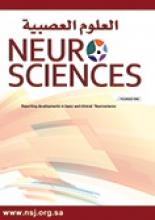Research ArticleOriginal Article
Open Access
Consanguinity in patients with mesial temporal lobe epilepsy due to hippocampal sclerosis in a Saudi population
Khalid S. Alqadi, Saba A. Rammal, Mosaab E. Alam, Ashwaq M. Alshahrani, Saleh S. Baeesa, Husam R. Kayyali, Fawzi A. Babtain and Youssef A. Al-Said
Neurosciences Journal August 2020, 25 (4) 276-280; DOI: https://doi.org/10.17712/nsj.2020.4.20200055
Khalid S. Alqadi
From the Department of Neurosciences (Alqadi, Alshahrani, Baeesa, Kayyali, Babtain, Al-Said), King Faisal Specialist Hospital, and Research Center, and from the Faculty of Medicine, King Abdulaziz University (Rammal, Alam, Baeesa), Jeddah, Kingdom of Saudi Arabia.
MDSaba A. Rammal
From the Department of Neurosciences (Alqadi, Alshahrani, Baeesa, Kayyali, Babtain, Al-Said), King Faisal Specialist Hospital, and Research Center, and from the Faculty of Medicine, King Abdulaziz University (Rammal, Alam, Baeesa), Jeddah, Kingdom of Saudi Arabia.
MDMosaab E. Alam
From the Department of Neurosciences (Alqadi, Alshahrani, Baeesa, Kayyali, Babtain, Al-Said), King Faisal Specialist Hospital, and Research Center, and from the Faculty of Medicine, King Abdulaziz University (Rammal, Alam, Baeesa), Jeddah, Kingdom of Saudi Arabia.
MDAshwaq M. Alshahrani
From the Department of Neurosciences (Alqadi, Alshahrani, Baeesa, Kayyali, Babtain, Al-Said), King Faisal Specialist Hospital, and Research Center, and from the Faculty of Medicine, King Abdulaziz University (Rammal, Alam, Baeesa), Jeddah, Kingdom of Saudi Arabia.
MDSaleh S. Baeesa
From the Department of Neurosciences (Alqadi, Alshahrani, Baeesa, Kayyali, Babtain, Al-Said), King Faisal Specialist Hospital, and Research Center, and from the Faculty of Medicine, King Abdulaziz University (Rammal, Alam, Baeesa), Jeddah, Kingdom of Saudi Arabia.
MD, FRCSCHusam R. Kayyali
From the Department of Neurosciences (Alqadi, Alshahrani, Baeesa, Kayyali, Babtain, Al-Said), King Faisal Specialist Hospital, and Research Center, and from the Faculty of Medicine, King Abdulaziz University (Rammal, Alam, Baeesa), Jeddah, Kingdom of Saudi Arabia.
MDFawzi A. Babtain
From the Department of Neurosciences (Alqadi, Alshahrani, Baeesa, Kayyali, Babtain, Al-Said), King Faisal Specialist Hospital, and Research Center, and from the Faculty of Medicine, King Abdulaziz University (Rammal, Alam, Baeesa), Jeddah, Kingdom of Saudi Arabia.
MDYoussef A. Al-Said
From the Department of Neurosciences (Alqadi, Alshahrani, Baeesa, Kayyali, Babtain, Al-Said), King Faisal Specialist Hospital, and Research Center, and from the Faculty of Medicine, King Abdulaziz University (Rammal, Alam, Baeesa), Jeddah, Kingdom of Saudi Arabia.
MD, FRCPC
References
- ↵
- Bittles A
- ↵
- Babtain F,
- Al-Shahrani A,
- Assiri K,
- Al-Kahaili A,
- Bhatia H,
- Velmurugan M
- ↵
- Khan H,
- Mohamed A,
- Al-Sakini Z,
- Zulfiquar K,
- Sohail A,
- Shaikh RB,
- Al Sharbatti S
- ↵
- Stoltenberg C,
- Magnus P,
- Skrondal A,
- Lie RT
- ↵
- Falconer MA
- ↵
- Berkovic SF,
- McIntosh A,
- Howell RA,
- Mitchell A,
- Sheffield LJ,
- Hopper JL
- Cendes F,
- Lopes-Cendes I,
- Andermann E,
- Andermann F
- ↵
- Wieser GH
- ↵
- Kobayashi E,
- Li LM,
- Lopes-Cendes I,
- Cendes F
- ↵
- Gambardella A,
- Labate A,
- Giallonardo A,
- Aguglia U
- ↵
- Souirti Z,
- Sghir A,
- Belfkih R,
- Messouak O
- ↵
- Al Jumah M,
- Kojan S,
- Al Khathaami A,
- Al Abdulkareami I,
- Al Blawi M,
- Jawhary A
- ↵
- Gambardella A,
- Messina D,
- Le Piane E,
- Oliveri RL,
- Annesi G,
- Zappia M,
- Andermann E,
- Quattrone A,
- Aguglia U
- ↵
- Labate A,
- Gambardella A,
- Andermann E,
- Aguglia U,
- Cendes F,
- Berkovic SF,
- Andermann F
- ↵
- Labate A,
- Ventura P,
- Gambardella A,
- Le Piane E,
- Colosimo E,
- Leggio U,
- Ambrosio R,
- Condino F,
- Messina D,
- Lanza P,
- Aguglia U
- ↵
- Labate A,
- Aguglia U,
- Tripepi G,
- Mumoli L,
- Ferlazzo E,
- Baggetta R,
- Quattrone A,
- Gambardella A
- ↵
- Winawer MR,
- Martinelli Boneschi F,
- Barker-Cummings C,
- Lee JH,
- Liu J,
- Mekios C,
- Gilliam TC,
- Pedley TA,
- Hauser WA
- ↵
- Angelicheva D,
- Tournev I,
- Guergueltcheva V,
- Mihaylova V,
- Azmanov DN,
- Morar B,
- et al.
- ↵
- Striano P,
- Gambardella A,
- Coppola A,
- Di Bonaventura C,
- Bovo G,
- Diani E,
- Boaretto F,
- Egeo G,
- Ciampa C,
- Labate A,
- Testoni S
- ↵
- Colosimo E,
- Gambardella A,
- Mantegazza M,
- Labate A,
- Rusconi R,
- Schiavon E,
- et al.
- ↵
- Scheffer IE,
- Harkin LA,
- Grinton BE,
- Dibbens LM,
- Turner SJ,
- Zielinski MA,
- et al.
- ↵
- Engel J.
- ↵
- McIntosh AM,
- Wilson SJ,
- Berkovic SF
- ↵
- Jeha LE,
- Najm IM,
- Bingaman WE,
- Khandwala F,
- Widdess-Walsh P,
- Morris HH,
- Dinner DS,
- Nair D,
- Foldvary-Schaeffer N,
- Prayson RA,
- Comair Y
In this issue
Consanguinity in patients with mesial temporal lobe epilepsy due to hippocampal sclerosis in a Saudi population
Khalid S. Alqadi, Saba A. Rammal, Mosaab E. Alam, Ashwaq M. Alshahrani, Saleh S. Baeesa, Husam R. Kayyali, Fawzi A. Babtain, Youssef A. Al-Said
Neurosciences Journal Aug 2020, 25 (4) 276-280; DOI: 10.17712/nsj.2020.4.20200055
Consanguinity in patients with mesial temporal lobe epilepsy due to hippocampal sclerosis in a Saudi population
Khalid S. Alqadi, Saba A. Rammal, Mosaab E. Alam, Ashwaq M. Alshahrani, Saleh S. Baeesa, Husam R. Kayyali, Fawzi A. Babtain, Youssef A. Al-Said
Neurosciences Journal Aug 2020, 25 (4) 276-280; DOI: 10.17712/nsj.2020.4.20200055
Jump to section
Related Articles
- No related articles found.
Cited By...
- No citing articles found.





